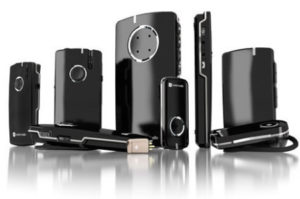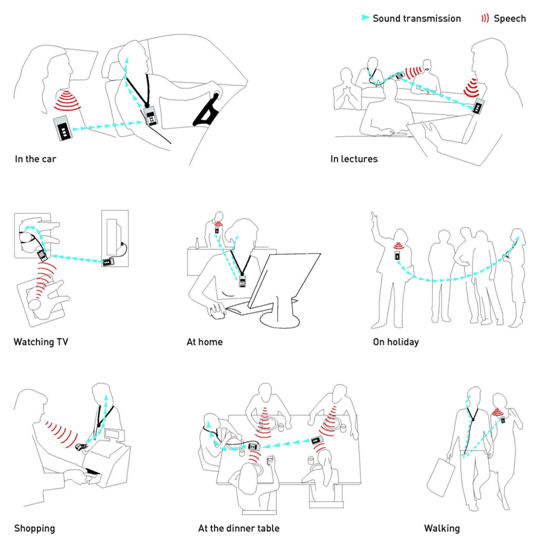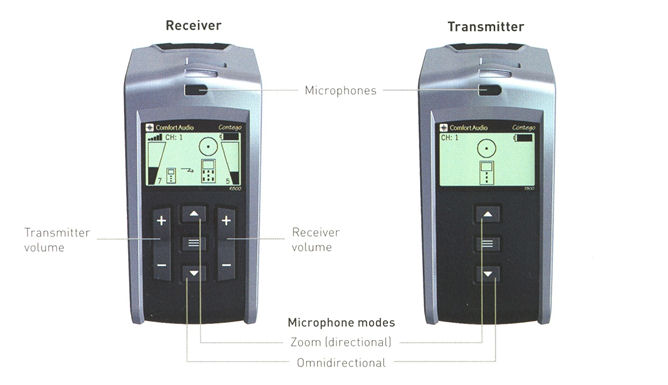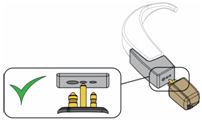FM systems

FM systems are wireless assistive hearing devices that enhance the use of hearing aids, cochlear implants and also assist people who are hard of hearing but do not wear hearing aids, in particular over distance and in noisy environments.
They enable sound to be picked up closer to a speaker, sound source or connected directly to the sound source and transmitted to the individual providing greater clarity of speech/sound and a reduction in background noise.
- FM System is the generic name or term that has been given to Radio Aids.
- FM is the abbreviation for Frequency Modulation.
- Frequency Modulation is a wireless transmission method used to transmit the sound.
- The main advantage for Hearing Aid wearers is that FM transmission is resilient to noise and interference helping to preserve the quality and clarity of the sound transmitted.
- Some companies are also using digital transmission but the products are still “labelled” as FM Systems.
- The abbreviation MHz means Mega Hertz (Mega = million, Hertz is the unit of frequency).
What is the advantage of a FM System?

A FM System empowers a hearing aid user with their own light weight, portable, flexible and discrete equipment that they can use in a great variety of daily situations where additional hearing assistance is required, as hearing aids alone, mainly due to background noise and distance, are not sufficient.
The legislation term “reasonable adjustments” has meant that there are businesses and organisations that have still not installed induction loops in strategic or customer facing areas and there are situations and places where there will probably never be induction loops. e.g. dining out, or sitting at a restaurant table.
While they should install induction loops a person with a FM System can almost go anywhere (they are not waterproof) with their equipment and therefore are less dependent on others.
How does a FM System work?
A traditional FM System comprises of two main parts – a radio transmitter and radio receiver. The transmitter captures sound via a microphone or direct connection to a sound source and transmits to the receiver.
Transmitters and receivers vary dependent on the manufacturer. Some have manual controls only while others have manual controls with a small screen for menu selection to set the transmission frequency between the transmitter and receiver and select the use of the audio input. The screen may also show the battery level, frequency channel and direction of the microphone.
Receivers
Receivers have different physical outlines, functions and methods of working with hearing aids or cochlear implants. One functional difference is that some receivers have an inbuilt microphone which depending on the situation can be used without the transmitter.
The different methods of receivers working with hearing aids or cochlear implants are:
Neckloop
The most common is the receiver with a neckloop that is worn around the neck. The receiver feeds the transmission into the neckloop which is your own personal induction loop and the hearing aid(s) or cochlear implant processor is set to the “T” position.
The telecoil, in the hearing aid or implant processor, picks up the magnetic field generated by the neckloop and the electronics in the hearing aid converts the magnetic field back to sound. The sound level received can be controlled by both the receiver and hearing aid/implant processor volume controls.
Direct Audio Input FM Receiver
If the hearing aid(s) or cochlear implant processor also have a Direct Audio Input a miniature receiver can be connected directly via an audio shoe (adaptor). The miniature receiver is powered by the hearing aid battery and the sound level received controlled by the hearing aid volume control. The “T” position is not used.
Direct Audio Input lead
If the hearing aid(s) or cochlear implant processor have a Direct Audio Input the receiver can be connected by a connecting lead directly to the hearing aid via an audio shoe (adaptor) rather than using a neckloop. The cable is normally supplied by the hearing aid manufacturer. The sound level received can be controlled by both the receiver and hearing aid volume controls.
Inductive Earhooks
Earhooks can replace a neckloop though not as common, especially when wearing glasses. The combination of hearing aids, glasses and earhooks can be uncomfortable for people. The sound level received can be controlled by both the receiver and hearing aid volume controls.
People who do not wear hearing aids can use the neckloop receivers with headphones or earphones. Some manufacturer’s now have a receiver, with volume control, that attaches to the ear. A miniature speaker is positioned over the outside of the ear canal or in the ear canal.
Transmitters
Transmitters on the majority of equipment have an integral microphone, an audio input and frequency selection. As systems have developed, in particular those using digital transmission, there is a selection of transmitters for the user to select from to provide a solution for their individual lifestyle. There are microphones that pick up from greater distances with functions that give the user more control over the quality and clarity of sound they receive and others with features that include Bluetooth and a Transmitter Receiver.
Bluetooth® connects the FM System to a Mobile Phone that also has Bluetooth®.
The caller’s speech is transmitted from the mobile to the FM Transmitter and from the FM Transmitter to the FM Receiver. The receiver’s speech is picked up by the microphone on the FM System and transmitted to the mobile.
The microphones usually have two or three positions
Omnidirectional – where the sound (speech) pick up is 360°
Directional
Directional with zoom
Audio Input – Line Input
Allows the transmitter to be connected to sound sources (TV, Radio, PC, MP3, Amplifiers etc.)
3.5mm stereo socket
Audio Input – Microphone Input
Allows an external microphone to be connected via the 3.5mm stereo socket
Frequency Selection
Dependent on the manufacturer some systems only have one transmission frequency
More than one frequency can be very useful as it provides you with the option to change to a different frequency if you are in a situation, where the sound you are receiving is noisy, possibly due to another person or organisation using the same frequency or one that is close.
Transmitter Receiver allows two microphones to be used to transmit simultaneously to receivers.
One microphone transmits to the other microphone, which contains a receiver, and this microphone transmits the sound from both microphones to the receivers.

Frequently asked questions
How are FM systems powered?
The majority of FM Systems have rechargeable batteries and are supplied, as standard, with battery chargers. Operating times are approximately 12 hours to 20 hours.
Are FM Systems heavy?
No. The transmitter and the receiver shown above each weigh 62g (2.19oz) and 64g (2.26oz) respectively.
Can you use more than one receiver with a transmitter?
Yes there are systems that work as a one to one and one to many.
Can people listen into the transmission between transmitter and receiver(s)?
That depends on the system. One of the systems shown above is secure and the other totally encrypted.
What distance do they transmit?
Systems vary from 15m to 50m.
Does the NHS provide FM Systems?
Not for adults.
Where can I obtain one?
From assistive hearing suppliers and hearing aid manufacturers.
If you are in employment or self employed and feel you require assistance in the workplace then systems may be obtained by making an application to Access to Work at Jobcentre Plus. For information please contact Hearing Link or visit the direct.gov website. Systems obtained through Access to Work belong to the employer.
In education, contact Hearing Link or visit the direct.gov website.
What will it cost?
Established systems from approximately £250 to £750. Newer systems from £800 to £4000.
Could I try before I buy?
Some companies will allow “try before you buy”; with others you will have to pay, then have your money refunded if the system is returned undamaged within a certain period of time. The time is stipulated by the seller.
Some charities loan equipment, as do some Social Services, but you will have to check.
Are they easy to operate?
Yes.
Do they work with a cochlear implant?
FM Systems work with cochlear implants. Speak with the supplier as you may also have to involve your implant centre.
Thanks to ihear for supplying the content on this page.
Images are shown courtesy of Comfort Audio AB.
Photos thanks to Phonak.
Webpage reviewed: March 2021




